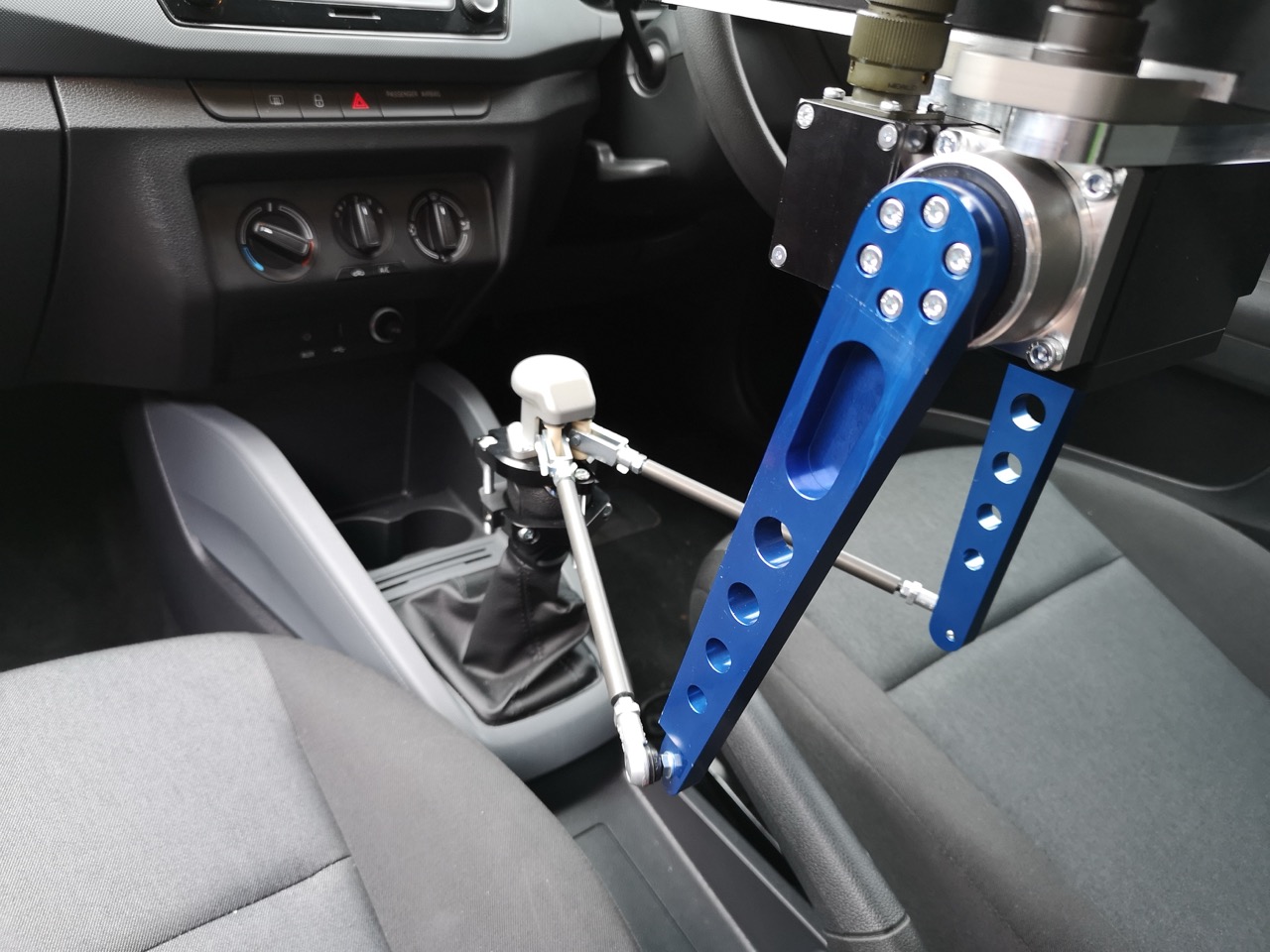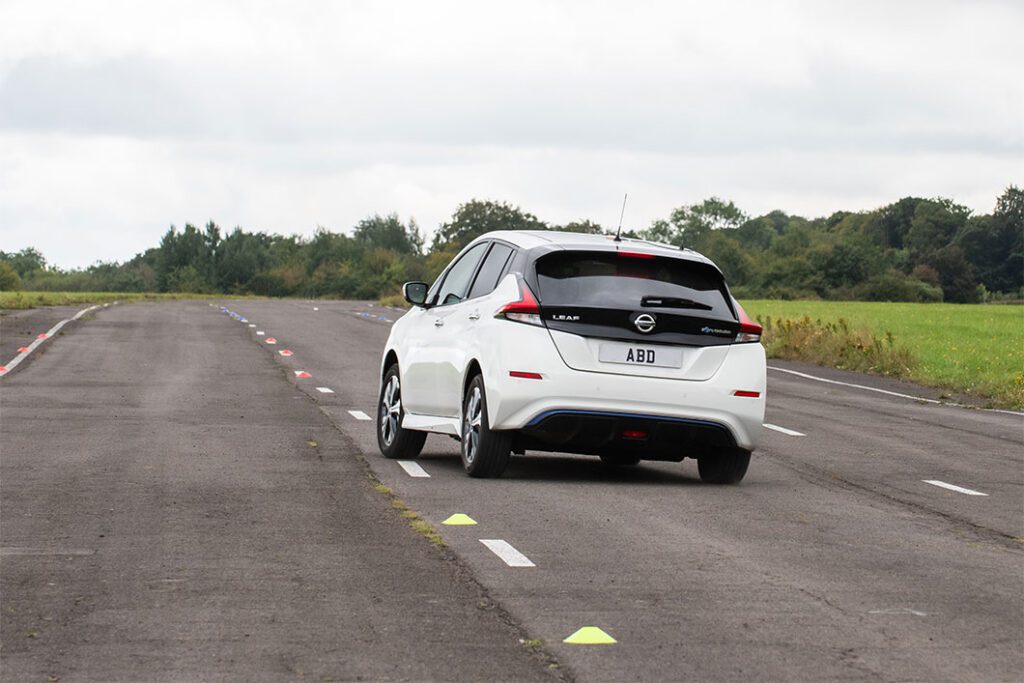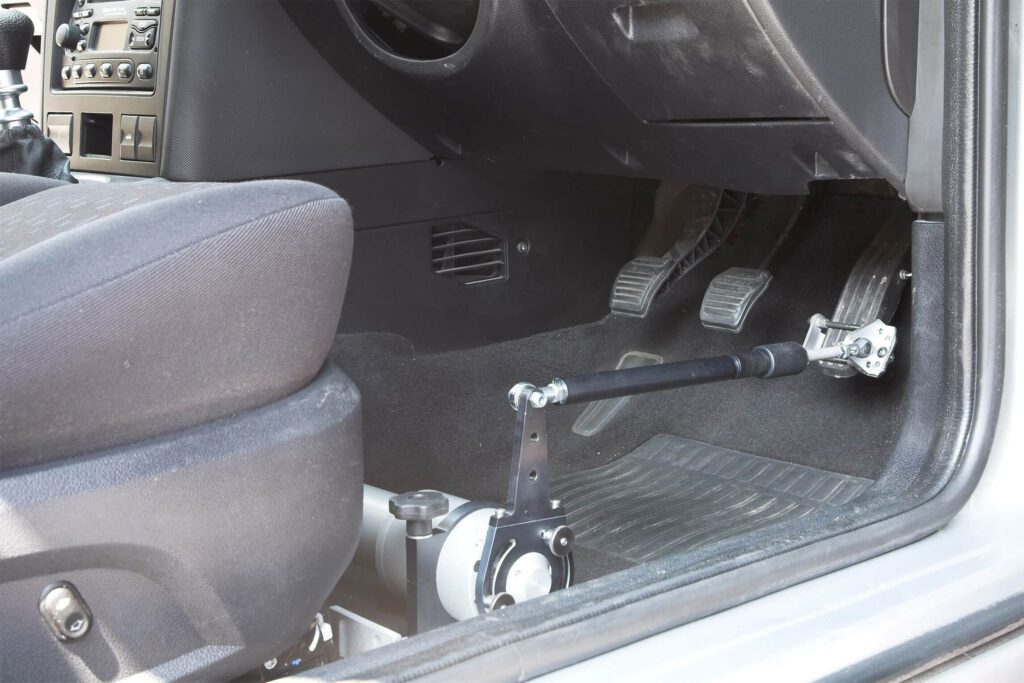Driverless Test System
Take the driver out of the vehicle and testing efficiency, precision and repeatability.
Take the driver out of the vehicle and testing efficiency, precision and repeatability.
AB Dynamics’ Driverless Test System uses driving robots and path following technology to guide the test vehicle along a pre-defined path with precise control of position, speed, and time. This system can handle various testing applications, such as vehicle dynamics and durability and misuse testing.
Customers commonly use driverless systems to accelerate lifetime vehicle testing, removing the risk of injury to their test drivers. With accurate path following and speed control, the robot will drive continuously on the harshest of surfaces, such as pothole drives, rough concrete, off-road and Belgian block, without the need to pause. The Driverless Test System safely manages multi-vehicle applications, meaning two operators can control over five vehicles, further increasing proving ground efficiency. Customers also use driverless systems to perform misuse tests, for example to perform repeated collisions with sandbanks, curbs, and severe potholes, achieving far higher accuracy and safety by the removal of humans from the test vehicle.
"*" indicates required fields
Controlling either throttle pedal position or vehicle speed, the AR Accelerator Robot uses a compact rotary actuator to control throttle pedal with precision and accuracy.
The AR Accelerator Robot is adjustable to fit in most vehicles and can be used in both right- and left-hand drive cars. When installed, it also allows normal driving by a driver. Used together with a steering robot and our Path Following software, the AR can reproduce the speed profile of a human driver, for example in laps of a circuit. Another typical application is the control of entry speed to a steering or braking test, with reduced throttle during the test. And like our other pedal robots, the AR is easily configured and controlled with our RC Software, which offers predefined templates for C-NCAP, Euro NCAP, JNCAP, NHTSA test scenarios and UN requirements, as well as custom options.
"*" indicates required fields
Controlling a vehicle’s clutch pedal with high precision and repeatability, tightly coordinated with the throttle and gear changer. The Clutch Robot is part of our solution for automating gear changes and pull away in any vehicle with manual transmission.
Designed to complement the CBAR pedal robot range, our Clutch Robot offers precise control over position and pedal speed, with fully customisable clutch and declutch profiles. This advanced system enables manual-gearshift vehicles to be operated robotically, accommodating both driver-onboard and driverless applications. The Clutch Robot delivers precise servocontrol for accurate and repeatable position inputs.
The Clutch Robot integrates seamlessly with the Gearchange Robot for use in manual transmissions, and allows the vehicle to accelerate from stationary, stop and reverse. Manoeuvres are programmed using Robot Controller (RC) Software, which seamlessly manages the planning, execution, and review of track tests using our driving robots. With RC Software, control of clutch bite points and pull away rates is easily learned by the robot and can be combined with CAN RPM feedback to give excellent, smooth control.
"*" indicates required fields
A compact and versatile robot, the CBAR 600 offers precision, reliability, and efficiency.
With its floor mounted actuator design, the Combined Brake and Accelerator Robot (CBAR) 600 can perform vehicle speed control tests with precision, reliability, and efficiency. Whether you need to comply with NCAP requirements, evaluate pedal feel, or explore new possibilities with driverless testing, the CBAR 600 provides accurate control of vehicle speed making it a perfect choice for any test that requires accurate, repeatable speed control.
Being controllable, versatile and user-friendly, the CBAR 600 can rapidly apply either the brake or accelerator pedals of most vehicles, and it can be easily configured and controlled with our RC Software, which offers predefined templates for for C-NCAP, Euro NCAP, JNCAP, NHTSA test scenarios and UN requirements, as well as custom options. The CBAR 600 can also be upgraded for driverless testing, and when combined with any of our steering robots the CBAR 600 becomes ideal for path following, vehicle dynamics, or brake assist testing.
"*" indicates required fields
A powerful and reliable robot, the CBAR 1000 can perform various brake and speed control tests.
Where more brake force is needed, the Combined Brake and Accelerator Robot (CBAR) 1000 – the big brother of the CBAR 600 – has enough power for aggressive brake testing. The CBAR 1000 has been specifically designed for high-performance vehicles that require high brake forces and high pedal speeds, delivering up to 1300 N of brake force and 800 mm/s of pedal speed. With the addition of an optional safety brake, the CBAR 1000 can be used for driverless applications.
This pedal robot is also suitable for general speed control use and ADAS testing, and like the CBAR 600, the CBAR 1000 shares a floor mounted actuator design and can also be easily configured and controlled with our RC Software, which offers predefined templates for for C-NCAP, Euro NCAP, JNCAP, NHTSA test scenarios and UN requirements, as well as custom options. Not only does this functionality save time and effort for the operator but also gives more flexibility and control over test criteria.
With a 1300 N max brake force, the CBAR 1000 robot is a powerful robot for brake tests and speed control.
"*" indicates required fields
Designed for remote, automated control of manual and auto transmissions, the gearchange robot enhances the capability of your driving robots, creating new testing possibilities.
The Gearchange Robot enables automated control of a vehicle’s gear selector, enhancing options for driverless vehicle control. The robot can be used with automatic and manual gearboxes, selecting drive, reverse or individual gears. It can also be used for tests with a human driver onboard or for laboratory test work. Our RC software automatically coordinates the motion of the clutch, gear change, and throttle actuators to give smooth gear transitions. In vehicles with manual gearboxes, it can either act as a pseudo automatic selector – changing gear according to speed and throttle inputs, or it can follow a defined gear sequence.
With the Gearchange Robot’s ability to change gears in a manual or switch modes in an automatic, driverless robots can do even more of the work for you and complete more realistic test cycles. Some of the applications of gearshift robots include testing the effects of reversing into a pothole or other obstacles (reverse misuse), testing the durability of the gearbox and clutch by repeatedly reversing and turning on an incline (the ‘driveway test’), and testing the advanced driver assistance systems (ADAS) of manual vehicles that need to follow a predefined speed profile. By using gearchange robots, you can reduce the human intervention and error in your testing process and achieve more realistic and reliable results.

*Note: Stroke is typically limited by spherical joint angle. Larger linear strokes may be accommodated on vehicles where the angular movement of the gear lever is less
"*" indicates required fields
You need to load content from reCAPTCHA to submit the form. Please note that doing so will share data with third-party providers.
More Information




